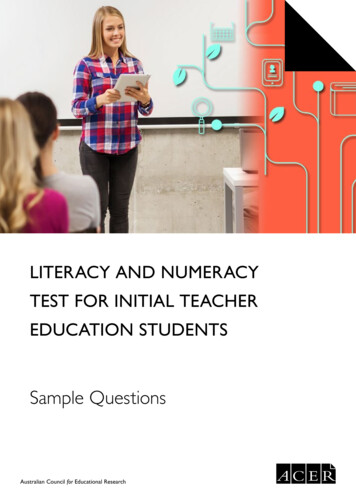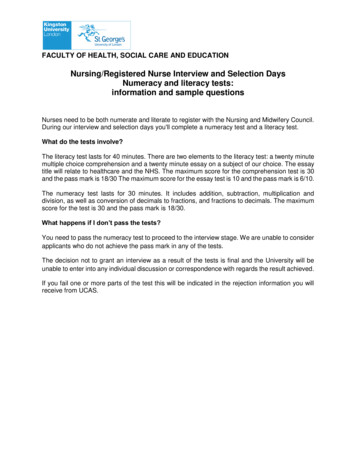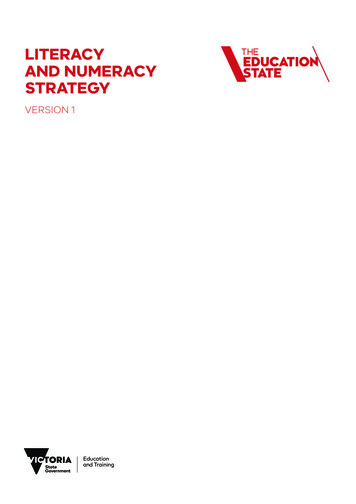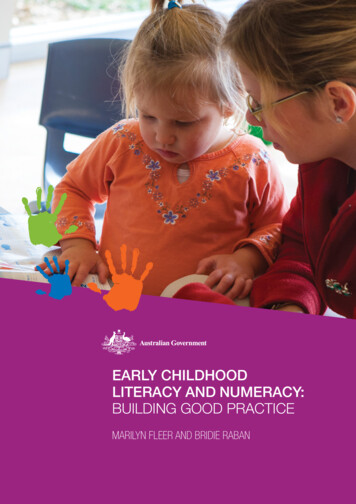
Transcription
LITERACY AND NUMERACYTEST FOR INITIAL TEACHEREDUCATION STUDENTSSample QuestionsAustralian Council for Educational Research
Literacy Sample QuestionsAnswers to the literacy questions are provided on page 8.LITERACY SAMPLE QUESTIONS 1 TO 6Questions 1 to 6 relate to the passage Change in Schools.CHANGE IN SCHOOLSThis text is taken from the introduction to Dancing on a Shifting Carpet: Reinventing traditional schooling forthe 21st century (2010).The contemporary context for schools is often referred to as ‘the knowledge era’ or ‘the knowledge society’,characterised by the constant creation and recreation of knowledge; the speed, complexity and interactivity ofinnovation; and the need for openness to new learning and new ways of thinking about and doing things.The level of change brought about by the knowledge era, and the pressures of other global and technologicalchanges mentioned earlier, inevitably have an impact on schools. These pressures originate from both externaland internal sources. There are external pressures on schools to fix the many social problems caused by rapidchange, and to prepare students to live and work in the knowledge society. There are also internal pressureswithin schools because their clientele – students and families – have changing expectations and needs.Within the wider external context, schools are seen as instruments of social change and are frequentlyexpected to cure or avert many societal ills by, for example, providing sex and drug education; increasingstudents’ environmental awareness; educating young people in matters of health and engaging them inphysical and emotional activities to improve their wellbeing and reduce obesity; and enhancing students’commitment to social justice.Within schools, the formal academic curriculum has been expanded to meet the social and psychologicalneeds of students. In increasingly fragmented societies, schools are expected to be havens of peace, safetyand stability, while still meeting the academic standards set by governments and the social and psychologicalexpectations of families and communities. Teachers and other school leaders are expected to be constantlyavailable and responsive to parents and their concerns, and schools are often held accountable for mattersoccurring outside regular school hours, which were traditionally the domain of parents and families. Whenmistakes happen at school, there is a tendency for parents to blame teachers and other school personnel,and to seek legal redress.All these factors have numerous implications for schools, not the least of which is that they need to changetheir forms of educational delivery to meet the needs of, and be relevant to, 21st century young people. Backin the late 1980s, Papert and Freire (n.d.) clearly foresaw the need for schools to change rapidly, even radically,if they were to remain vital to society:. it is inconceivable that school as we’ve known it will continue. Inconceivable. And the reason whyit’s inconceivable is that little glimmer with my grandson who is used to finding knowledge whenhe wants to and can get it when he needs it, and can get in touch with other people and teachers,not because they are appointed by the state, but because he can contact them in some networksomewhere. These children will not sit quietly in school and listen to a teacher give them predigested knowledge. I think that they will revolt. (Part 2)LITERACY AND NUMERACY TEST FOR INITIAL TEACHER EDUCATION STUDENTSSample Questions3
The revolt may not have happened as yet, but the Australian Government is now talking about the need for arevolution in education and schools (Department of Education, Employment and Workplace Relations, 2008).The core of this ‘revolution’ focuses on the quality of teaching, the quality of learning and the quality of studentoutcomes. Conventional teaching and learning modalities are under widespread critique.Source: Leoni Degenhardt & Patrick Duignan, Dancing on a Shifting Carpet: Reinventing traditional schoolingfor the 21st century. ACER Press, 2010.Literacy Sample Question 1The changes in schools recommended in the text can best be summarised asAincreasing academic rigour.Bresponding to a range of competing demands.Cprioritising community wishes over government directives.Dusing technology to achieve traditional goals more successfully.Literacy Sample Question 2According to the text, how do parents tend to respond to problems at school?Aby blaming societal illsBby blaming someone in the schoolCby calling for increased resourcingDby calling for the curriculum to be expandedLiteracy Sample Question 3. schools are expected to be havens of peace, safety and stability . (paragraph 4)According to the text, why is this more expected of schools today than in the past?4Abecause society no longer gives this kind of supportBbecause these qualities have been shown to enhance learningCbecause authorities are committed to avoiding student revoltsDbecause parents have given up on trying to control their childrenLITERACY AND NUMERACY TEST FOR INITIAL TEACHER EDUCATION STUDENTSSample Questions
Literacy Sample Question 4Back in the late 1980s, Papert and Freire (n.d.) clearly foresaw the need for schools to changerapidly, even radically, if they were to remain vital to society. (paragraph 5)Which word in this sentence indicates that the writers endorse the position of Papert and Freire?AclearlyBrapidlyCradicallyDvitalLiteracy Sample Question 5How does the quotation from Papert and Freire relate to the rest of the text?AIt summarises the text’s main position.BIt documents the origin of the text’s main idea.CIt suggests a solution to a problem raised in the text.DIt provides a more extreme point of view than the text.Literacy Sample Question 6Papert and Freire refer to the learning experience of a contemporary child (my grandson).Do Papert and Freire identify the features listed below as part of this child’s learning experience?Select ‘Yes’ or ‘No’ for each feature.FeatureYesNoimmediacydiverse sources of informationrespect for authorityLITERACY AND NUMERACY TEST FOR INITIAL TEACHER EDUCATION STUDENTSSample Questions5
LITERACY SAMPLE QUESTIONS 7 TO 10Questions 7 to 10 relate to a school history excursion, described in the following passage.HISTORY EXCURSIONOur Year 9 students will be spending two weeks in a rural community to learn more about life there. Studentswill focus on issues that have affected these settlements over time. They will be given opportunities to meetand talk with local residents. Students will work on assignments designed to help explain their history. Allstudents have been given explicit instructions about how to record their findings during the excursion.Literacy Sample Question 7Which underlined reference in the text is ambiguous?Alife thereBthese settlementsCTheyDtheir historyLiteracy Sample Question 8All students have been given explicit instructions about how to record their findings duringthe excursion.Which of the following is closest in meaning to explicit?6AextensiveBsimpleChands-onDclearly statedLITERACY AND NUMERACY TEST FOR INITIAL TEACHER EDUCATION STUDENTSSample Questions
Literacy Sample Question 9Below are four versions of a sentence from a student’s assignment about the history excursion.Which version has acceptable punctuation?A‘Our community, is not static,’ she said. ‘It is constantly changing.’B‘Our community is not static’ she said ‘it is constantly changing.’C‘Our community is not static,’ she said. ‘It is constantly changing.’D‘Our community is not static, she said, it is constantly changing.’Literacy Sample Question 10If the sentence below contains a spelling error, correct the error by writing the word as it shouldappear; if there is no error, write N.It is no exageration to say that the students’ insights into historical processes and social conditionswere impressive.LITERACY AND NUMERACY TEST FOR INITIAL TEACHER EDUCATION STUDENTSSample Questions7
Literacy answersLiteracy Sample Questions8Question 1BQuestion 2BQuestion 3AQuestion 4AQuestion 5DQuestion 6Yes, Yes, No in that orderQuestion 7DQuestion 8DQuestion 9CQuestion 10exaggerationLITERACY AND NUMERACY TEST FOR INITIAL TEACHER EDUCATION STUDENTSSample Questions
Numeracy Sample QuestionsAnswers to the numeracy questions are provided on page 18.SECTION ONECalculator available. Pen and paper may be used.Numeracy Sample Question 1EDUCATION EXPENDITUREGovernment operating expenditure on education refers mainly to money spent on schools andtertiary education.Of the total operating expenditure on education in 2011–2012, 51% was spent on primary andsecondary education and 36% on tertiary education (universities and TAFEs).What percentage of the total operating expenditure on education in 2011–2012 was spent on theremaining aspects of the education budget?%Numeracy Sample Question 2GYM COSTSHere is the schedule of costs for Gym and Swim memberships at a sports facility.Gym only( )Swim only( )Gym and Swim( )5964617735133663302955021251512 Months (upfront)12 Months (monthly debit)6 Months (upfront)Casual (per visit)For a 12-month ‘Gym and Swim’ membership, how much more does it cost to pay by monthlydebit rather than upfront? LITERACY AND NUMERACY TEST FOR INITIAL TEACHER EDUCATION STUDENTSSample Questions9
NUMERACY SAMPLE QUESTIONS 3 AND 4SCHOOL DIRECTIONSBeckett Primary School is located at grid reference D3 of this street map.ACDConway StPower StBruce St1BKenny StKenny StPower St34BeckettPrimarySchoolAllen StConway St2NAllen StMain Rd400 mMain Rd400 m10LITERACY AND NUMERACY TEST FOR INITIAL TEACHER EDUCATION STUDENTSSample Questions
Numeracy Sample Question 3Angela is driving south along Bruce St (reference A1).Which of these directions would lead Angela to Beckett Primary School?Select ‘Yes’ or ‘No’ for each set of directions.DirectionsYesNoGo right into Kenny St, right into Power St, right into Allen St.Go east into Kenny St, south into Power St, east into Allen St.Go east into Kenny St, across Power St, south into Conway St, right into Allen St.Numeracy Sample Question 4The side-length of each grid square is 400 metres.Which of these values is closest to the area of Beckett Primary School in square metres?A1 000B4 000C10 000D40 000E80 000LITERACY AND NUMERACY TEST FOR INITIAL TEACHER EDUCATION STUDENTSSample Questions11
Numeracy Sample Question 5SCIENCE RESULTThis table shows the overall achievement required for different awards in a tertiary science subject.AwardAchievementHigh Distinction80% and y50%–59%Unsatisfactorybelow 50%The science subject has three assessment tasks. Each task is weighted as follows:Assessment Task 1: weight 60%Assessment Task 2: weight 30%Assessment Task 3: weight 10%Alex’s result for each task was:Assessment Task 1: 70%Assessment Task 2: 80%Assessment Task 3: 90%What is Alex’s award for science?12AHigh Y AND NUMERACY TEST FOR INITIAL TEACHER EDUCATION STUDENTSSample Questions
Numeracy Sample Question 6PLAYING SPORTThese graphs show the percentage of children (11–13 years) playing sport at different times duringschool days and during non-school days.Percentage of Children Playing Sport25school days20percentage1510506810121416182022time of day25non-school days20percentage1510506810121416182022time of daySource: University of South Australia (2004), Children in SportThe table below contains statements about the graphs.Select ‘True’ or ‘False’ for each statement.StatementTrueFalseOn school days, the highest percentage of children playing sport at anyone time is less than 25%.At any given time on a non-school day, approximately 90% or more ofchildren were not playing sport.At 5 pm, fewer children were playing sport on school days than onnon‑school days.LITERACY AND NUMERACY TEST FOR INITIAL TEACHER EDUCATION STUDENTSSample Questions13
Numeracy Sample Question 7VET COURSESA secondary school offers one-year Vocational Education and Training (VET) courses.Courses may be taken at one of three levels: Certificate I, II or III.Students may enrol for only one certificate within each school year.This table compares the number of students enrolled in one of the courses with the number ofstudents who completed a qualification in that lNumber of students enrolled inJanuary 201197185120Number of students completedin December 20115013366What percentage of the total enrolments completed VET Certificates at the school in December2011?%14LITERACY AND NUMERACY TEST FOR INITIAL TEACHER EDUCATION STUDENTSSample Questions
Numeracy Sample Question 8BAND ACHIEVEMENTThis graph shows the percentage of Year 3 students in six achievement bands for reading, for aselected school.It also shows comparable percentages for statistically similar schools and for all Australian schools.Year 3 ReadingPercentage of students in each band40Selected school35Statistically similar schools30Australian schools2228222121159034110111412023456 or aboveBandThe table below contains some statements about the graph.Select ‘True’ or ‘False’ for each statement.StatementTrueFalseA higher percentage of Year 3 students at the selected school achieved atBand 4 compared to students at statistically similar schools.At the selected school, more Year 3 students achieved at Band 4 than atany other band.A greater percentage of the Year 3 students at the selected school achievedabove Band 3 compared to Year 3 students at statistically similar schools.LITERACY AND NUMERACY TEST FOR INITIAL TEACHER EDUCATION STUDENTSSample Questions15
SECTION TWOCalculator not available. Pen and paper may be used.Numeracy Sample Question 9ONE HUNDRED BOXESThe weight of a box of stationery is 3.2 kilograms.What is the weight of 100 such boxes?kilogramsNumeracy Sample Question 10GEOGRAPHICAL DISTRIBUTION OF AUSTRALIANSThe Australian Bureau of Statistics conducts a census every five years.In 2011, the population of Australia was 22 million.About 2% of these people lived in remote or very remote areas.About how many people lived in remote or very remote areas in Australia in 2011?16A11 000B44 000C110 000D440 000LITERACY AND NUMERACY TEST FOR INITIAL TEACHER EDUCATION STUDENTSSample Questions
Answers to the numeracy questions are provided on the next page.
Numeracy answersNumeracy Sample QuestionsSECTION ONE: Calculator available.Question 113Question 219Question 3No, Yes, Yes in that orderQuestion 4DQuestion 5BQuestion 6True, True, False in that orderQuestion 755Question 8True, False, True in that orderSECTION TWO: Calculator not available.18Question 9320Question 10DLITERACY AND NUMERACY TEST FOR INITIAL TEACHER EDUCATION STUDENTSSample Questions
Copyright 2015 Australian Council for Educational Research
3 Literacy Sample Questions Answers to the literacy questions are provided on page 8. LITERACY SAMPLE QUESTIONS 1 TO 6 Questions 1 to 6 relate to the passage Change in Schools. CHANGE IN SCHOOLS This text is taken from the introduction to Dancing on a Shifting Carpet: Reinventing traditional schooling for the 21st century (2010).










